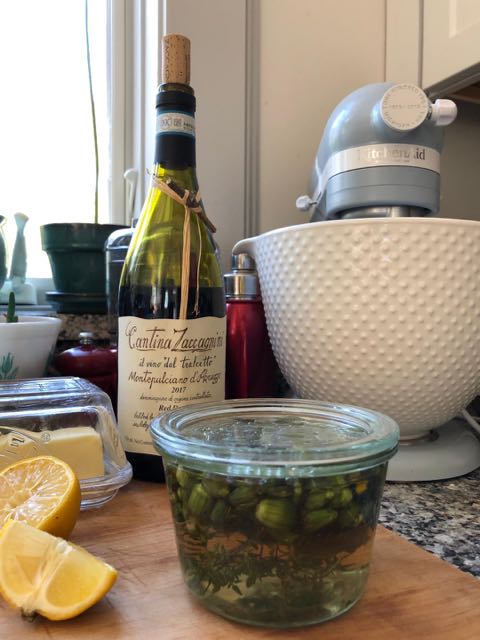Springtime Wild Edibles
By Marie-Christine Perry

Before our kitchen gardens start brimming with the first fruits and vegetables, we can turn to foraging to have a few options for fresh greens, flowers and roots as we take walks through woods and meadows. Foraging for wild edibles is a great pleasure, but one must exercise caution. The first rule of foraging is to be 100 percent sure you know the plants you pick. This knowledge comes from research and long experience, and it is wise to learn from experts. Avoid picking wild edibles along country roads, and find instead a meadow, or your own garden!
But today I want to talk about a few plants known to those who have a piece of land, a garden, even just a lawn: dandelion, garlic mustard and Japanese knotweed—all weeds really. I will add watercress, which is so delicious when wild, because our area is blessed with many creeks and brooks.
Dandelion (Taraxacum officinale), the enemy of lush and orderly lawns, is a complete gift for the adventurous cook: it is plentiful, unwanted, quite a pest in fact, and every single part of the plant is edible: flower, stem, leaves and roots! Dandelions contain vitamins A, C, D, E, K, and B complex, as well as minerals such as potassium, calcium, and iron. Eating dandelion greens is beneficial to your liver and gall bladder.
Choose the youngest leaves for your salad, and simply dress your greens with virgin olive oil, sea salt, and a few drops of balsamic vinegar. A sprinkling of golden florets will enhance the presentation! Dandelion greens are also delicious sautéed with caramelized pancetta, coarse pepper and a squeeze of lemon before serving, and as an addition to soups and stews, particularly paired with cannellini beans.
The unopened dandelion buds can be pickled into dandelion capers. Gather a cup of tight buds, remove the bracts under the bud, put them in a mason jar with two bay leaves and two sprigs of fresh thyme, a tablespoon of sea salt and a tablespoon of sugar, and cover with a cup of boiling water. Let the buds brine for three days, drain, put the buds, the bay leaves and the thyme back into the jar, cover with a cup of hot white wine vinegar. Resist the temptation to open for the next two weeks, then refrigerate and use as you would capers.
The most wonderful use of the flowers is dandelion honey, a golden syrup I use in herbal tea (it makes a cup of chamomile tea sing), on crêpes and pancakes, on top of homemade vanilla ice-cream, and anywhere I would use honey. Gently bring to a boil two cups of blossoms (remove the green bracts at the base of the flower head) in four cups of water, keep on low heat for a half hour, and let cool overnight. The next morning, strain the liquid and measure, adding equal amount of sugar to the tea and the juice of a lemon, and bring again to a boil until temperature reaches 220 degrees, fill mason jars and process in water bath for 10 minutes. The colour of this honey is pale gold, and it is very fragrant. The taste is reminiscent of natural honey. The first time I made it I felt like bees must feel when they have filled the alveoli of the hive with their nectar! By adding pectin to the syrup you can make dandelion jelly.
Garlic mustard (Alliaria petiolata) is a brassica from the mustard family and an invasive plant in our gardens and wild meadows, which is a good reason to eat it! Its greens are high in vitamin A and vitamin C, and its flavour is mild and sweet, with distinct garlic notes. In my latest garlic mustard pesto I used cashew nuts, but almonds, walnuts, and of course pine nuts, would work as well. Put two large handfuls of greens in your food processor with a little water, a handful of nuts and purée slowly with a stream of olive oil and sea salt. Add a little water if too sticky, and enough olive oil to get a creamy, vibrant green paste. Put into jars and refrigerate. Surplus can be frozen. This pesto is wonderful on delicate pasta.
Japanese Knotweed (Reynoutria japonica) is a fast-growing invasive weed, but if you catch it in spring, it can also be a key ingredient in a number of tasty desserts. The ideal time to eat the weed is mid-April to early June, when the first shoots (up to 8 inches in height) are tender enough to eat. Japanese knotweed should only be eaten at this time of year, as when it is fully grown it can cause mouth blisters. It tastes much like a lemony rhubarb, and its sweet taste is especially complimentary in desserts such as crumbles, muffins and more.
Watercress is plentiful along lively streams and creeks. Gather only where watercress branches are moving in the current, along easily accessible stream banks. Wash thoroughly, eat as a salad with virgin olive oil and sea salt, or make a nutritious soup. For two large handfuls of watercress, boil one large starchy potato in salt water to cover, blend the potato and its water in food processor with your raw cleaned watercress, season with fresh ground pepper, and add crème fraîche to taste. Voilà! Forage safely, and bon appétit!
